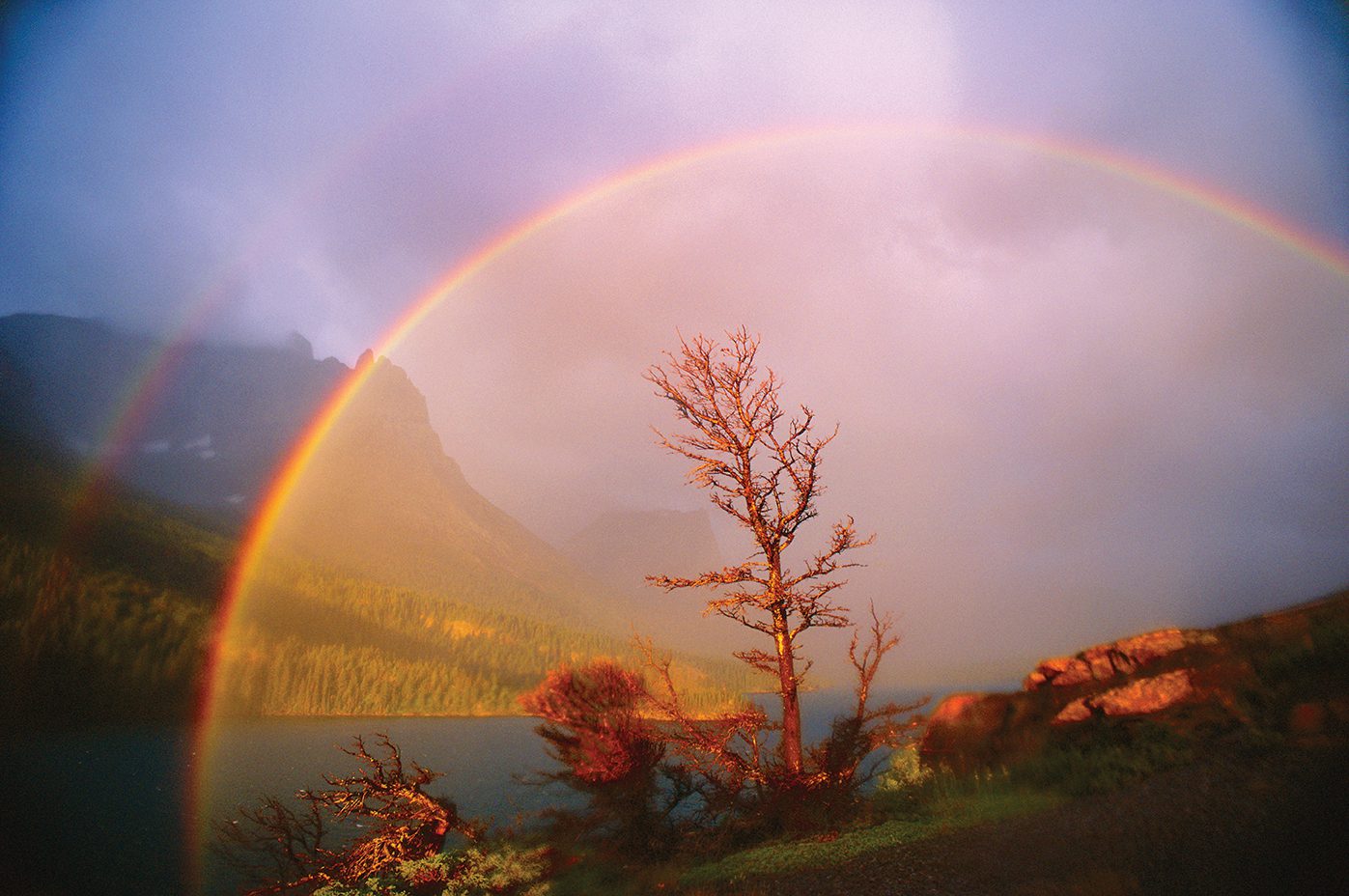
27 Sep Galen Rowell: A Dynamic Mountain Light Remembered
MORE THAN 20 YEARS AFTER HIS TRAGIC DEATH, THE WORLD-RENOWNED PHOTOGRAPHER AND MOUNTAINEER CONTINUES TO INSPIRE FUTURE GENERATIONS—AND REMAINS CLOSE TO THE HEART OF AN OLD FRIEND
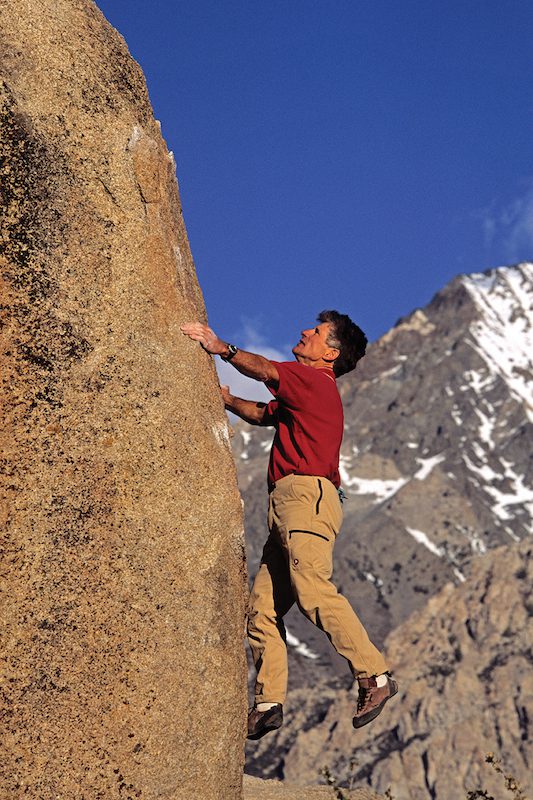
Galen Rowell climbs in the Buttermilks in the Eastern Sierra in spring 2002, just months before his tragic death, photo by Zach Holmes / Alamy Stock Photo
In 1969, I was walking along the base of El Capitan in Yosemite Valley with a couple of climbing buddies when we ran into Galen Rowell. I was new to the sport and not up on my Yosemite climbing history, and thus had never heard Galen’s name.
We were introduced, and I was immediately struck by the fierce intensity of his person. His handshake was firm, his smile sincere and there was a gleeful, wild passion in his eyes that I liked and trusted from the very beginning. We climbed together part of that day and began a friendship that endured and immeasurably enriched and informed my life.
Reflecting on my good friend, I believe Galen’s work has enriched and made more secure the lives of all who inhabit the earth. I say this because his work has raised man’s awareness of the beauty, the inherent dignity, the fragility and the spiritual dimension of the wild places, creatures and people of the world. Only human awareness can save the wild, and the essence of Galen’s success and vision was in the intense enthusiasm he brought to whatever he was doing.
I have known few people with the kind of energy and ability to focus in the moment as Galen. Whether he was climbing, taking photographs, giving a talk, discussing the ideas of Konrad Lorenz, the observations of John McPhee, the music of Villa Lobos, or taking one of his power runs in the Berkeley Hills, life was always an adventure for him.
Anyone who was ever in an automobile with Galen at the wheel experienced a memorable adventure of their own. I was once in the car with Galen on Highway 395 north of Bishop on the way to a favorite bouldering spot when I expressed my uneasiness at our speed. Galen guffawed with glee and said, “Relax, you’ve skied faster than this,” then picked up more speed.
It has been one of the great privileges of my life to have shared adventures with Galen—in his beloved Sierra Nevada, the Rockies, China, Tibet and Berkeley.
A Natural Rebel
Galen was born into intellectual, environmental, cultural, academic and musical royalty of Berkeley in 1940.
His mother, Margaret Avery Rowell, was one of the finest cellists of the time, playing concerts around the world and teaching at the San Francisco Conservatory of Music, UC Berkeley, Stanford University, Mills College and San Francisco State University. She said of her teaching: “I don’t teach the cello … I teach the human being,” and that one of her primary concerns was “the liberating of students to develop their own unique potential.”
Galen’s father, Edward Z. Rowell, was a professor of philosophy at UC Berkeley, Carleton College and the University of Chicago. His monograph, Prolegomena to Argumentation, is considered a major contribution to rhetorical theory and has long been used as a central oeuvre in graduate courses.
The Rowells were avid campers, hikers and explorers, and much of Galen’s early life was spent with and without his parents on extended trips in the Sierra Nevada with the Sierra Club, which is how he was introduced to climbing. He also was the paper boy, neighbor, lifelong friend and acolyte of David Brower, one of America’s finest environmentalists and mountaineers.
But Galen was a natural rebel who followed his own mind and code of ethics. After graduating from Berkeley High School in 1958, he enrolled at UC Berkeley but soon dropped out and opened an auto repair shop. He married early, had two children and spent almost every weekend and sometimes more climbing in Yosemite—a well-known scenario for destroying marriages.
Adventurous Soul
After his divorce, Galen remained close with his son Tony and daughter Nicole, and often brought them along when he’d stay with me and my son Jason in Truckee during the mid-1970s.
By that time Galen was well-known for both his mountaineering feats and photography career, which received a significant boost in 1972 when his images were featured in a National Geographic cover story on Yosemite.
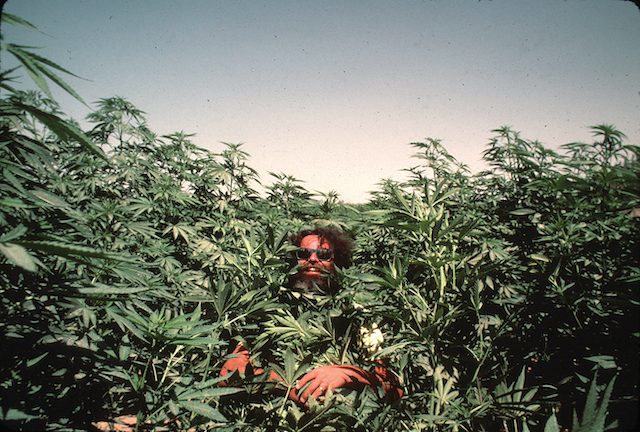
On a 1980 trip to climb China’s Muztagh Ata, Galen Rowell and author Dick Dorworth (pictured) visit a hemp field near the city of Kashgar, photo by Galen Rowell
With a desire for outdoor adventure and a strong background in one of the world’s premier climbing locations, Galen went on to record more than 100 first ascents in the Sierra Nevada and summited some of the world’s highest peaks, including Mount Everest and K2, among others. He made the first one-day ascents of Mount Kilimanjaro and Denali, and in 1997 became the oldest person to climb El Capitan in a day, at age 57. Over the last two decades of his life, he embarked on more than 35 trips to mountain ranges across the globe.
But ultimately, he never abandoned his home state or his favorite mountain range.
Among the notable quotes Galen left us with, he said: “Although I plan to continue traveling to and photographing exotic places indefinitely, I have a confession to make. I’ve known all along that more of what I am seeking in the wilds is right here in my home state of California than anywhere else on earth. But there’s a ‘Catch-22.’ I couldn’t say it with authority until I had all those journeys to Tibet, Nepal, Pakistan, China, South America, Antarctica and Alaska behind me.”
Somewhat ironically given his athletic achievements, Galen was not someone I would describe as a natural athlete. Rather, his athleticism grew not from being unusually agile, quick or strong, but from his complete commitment to everything he did, including training and being in the present moment—and, of course, never backing down when there was any hope or energy left.
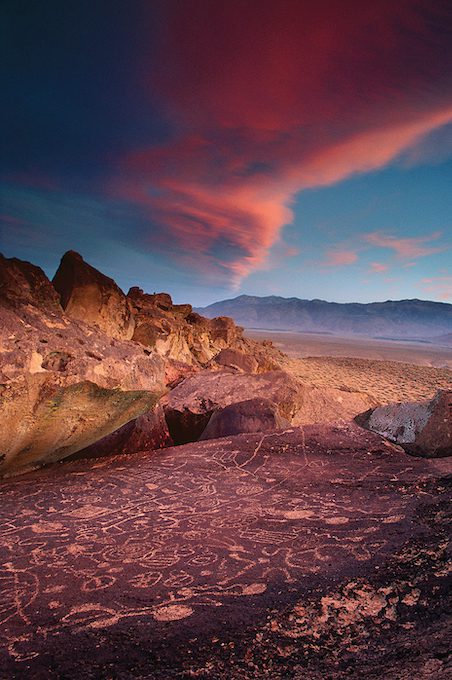
Sierra Wave over petroglyphs in Owens Valley near Bishop, photo by Galen Rowell / Mountain Light / Alamy Stock Photo
Photographer of Legend
When it came to photography, Galen was very much a natural. Yet, as with his athletic pursuits, it was his unparalleled dedication and passion for the wild places he photographed that set him apart as one of the best wilderness photographers of all time.
“You only get one sunrise and one sunset a day, and you only get so many days on the planet,” Galen said. “A good photographer does the math and doesn’t waste either.”
With a camera in hand, Galen was fully immersed in the natural world around him, with the unique ability and ambition to reach remote locations that few photographers would venture. He described his style as “participatory photography” and his photos as “dynamic landscapes,” which, as he wrote, “combine a personal vision with splendid natural events. The results are images that depict landscapes not only as recognizable natural scenes, but also as what appear to be unrepeatable moments that evoke strong emotions.”
After his 1972 cover story—one of many National Geographics that featured his photography over the years—Galen went on to publish 18 books showcasing his work, including his best-selling classic Mountain Light: In Search of the Dynamic Landscape. He was the recipient of many awards, most prestigiously the Ansel Adams Award in 1984 for his contributions to the art of wilderness photography. In 1992, he received a National Science Foundation Artists and Writers Grant to photograph Antarctica.
Galen was a capable writer as well, and his books have influenced many amateur and professional photographers alike over the years.
Inspiring Generations
One example is Keoki Flagg, the award-winning fine art photographer and owner of Gallery Keoki in Olympic Valley, who credits Galen for showing him “the true potential and power of adventure photography.”
After graduating from college, Keoki says he began a four-year adventure traipsing the globe when he got his hands on the book Galen Rowell’s Vision: The Art of Adventure Photography, which left him with a newfound respect for one of history’s most famous photographers.
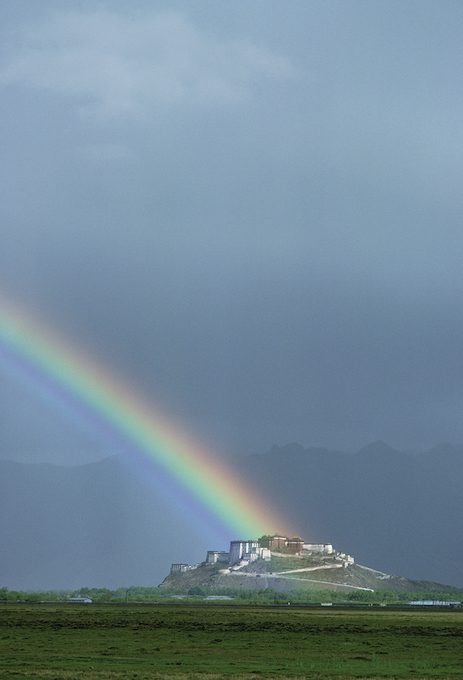
Rowell’s famous Rainbow Over the Potala Palace image, taken in Lhasa, Tibet in October 1981, photo by Galen Rowell / Mountain Light / Alamy Stock Photo
“I was familiar with his incredible wildlife/nature photography. The way he captured shots of wildlife integrated in their natural habitat was so perfect that sometimes it almost didn’t feel real,” Keoki says. “But his book showcased his adventurous imagery and sparked my soul, inspiring me to follow a path of global adventure and creative translation that still inspires me almost 40 years later.”
Among the attributes Keoki admires most about Galen as a photographer was his full commitment to getting the perfect shot. He tells the story behind one of Galen’s more renowned images, Rainbow Over the Potala Palace, which I can confirm because I was there with Galen when he shot it.
“The story goes that he was in Lhasa, Tibet, when he saw the rainbow in the sky near the palace,” Keoki says. “He tried desperately to find transportation to get to a better vantage point, but had no luck, so, instead of giving up, he grabbed his camera and tripod and ran nearly a mile to reach the perfect spot to give him the desired perspective where everything lined up—a celestial rainbow directly over the palace. It is a timeless, iconic image that speaks to the spirituality of divine light, and it only happened because of Galen’s fanatic desire to get it just right.”
Nick Cahill is another local photographer following in Galen’s footsteps, right down to landing his own National Geographic cover (of a starry night sky over Lake Tahoe).
“What I’ve always admired about Rowell was how he didn’t just capture landscapes—he lived them,” Nick says. “His use of natural light, particularly in those fleeting moments at dawn or dusk, has always stuck with me. It’s not just about the location; it’s about capturing the energy of the place in the exact right moment.
“For me, Rowell showed that getting the shot isn’t just about photography—it’s about being fully immersed in the adventure. His legacy continues to remind me why I’m drawn to these wild places and what drives me to keep exploring them.”
Perfect Match
Of course, no tribute to Galen is complete without the inclusion of his life partner, Barbara Cushman Rowell.
Galen met his to-be wife in 1981 at The North Face, where she worked as a PR rep. It was love at first sight. They immediately embarked on a phenomenal partnership. Like every relationship, theirs was not without difficult times, but I consider Barbara and Galen one of the true great love stories of our circle of friends.
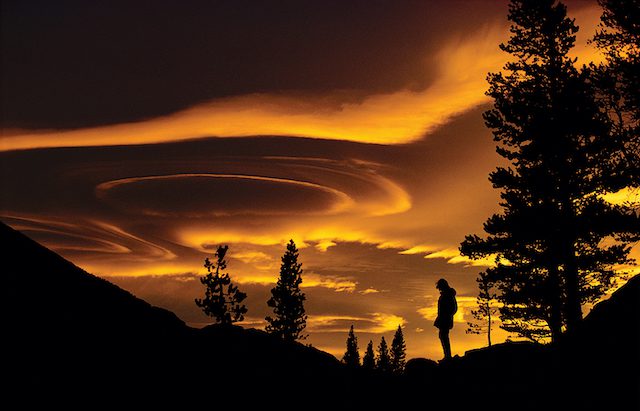
A sunrise on Yosemite’s Tioga Pass, photo by Galen Rowell / Mountain Light / Alamy Stock Photo
In so many ways they were a perfect match. The most obvious example is that while Galen provided the images that made Mountain Light—the photo gallery they opened in 1983—what it was, it was Barbara who made the business run smoothly. They supported, encouraged, prodded and pushed each other in the lifelong project of continuing to grow, continuing to learn and continuing to expand their personal and professional horizons.
In the process, they expanded the inner and outer horizons of all mankind, thanks be given.
Tragically, on August 11, 2002, Galen and Barbara were returning from a photography workshop in Alaska when their plane crashed near the Bishop airport, killing all four on board, including the pilot and a friend. Galen was 61 and Barbara 53.
After his upbringing on Tahoe’s South Shore, Dick Dorworth went on to a successful skiing and writing career, setting a world speed skiing record of 106 miles per hour, publishing seven books and writing for dozens of publications. Find more of his work at dickdorworth.com.




Steve Shuey
Posted at 09:08h, 30 OctoberWhat a nice remembrance. Thanks for writing this. I was luck enough to take 2 workshops from him, the last was the summer before he passed. I still use things I learned from him in my nature photography. I have two signed prints and nearly all his books as they are what inspired me to take outdoor/nature/landscape photography more seriously. I have often wondered what he would have continue to do if not taken so early. Thanks again for this nice tribute.